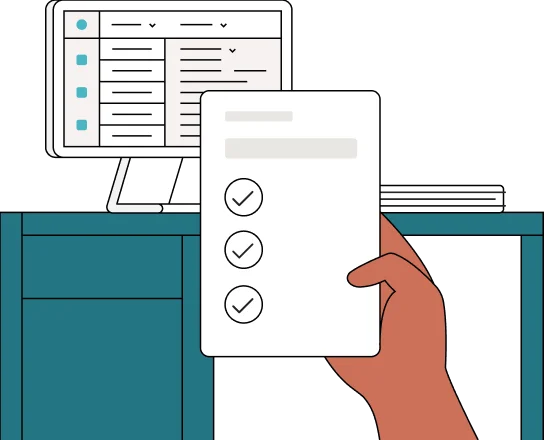A revocable living trust is one of the most versatile documents in estate planning. It gives you complete control over how your assets are managed and distributed, while helping your loved ones avoid the time and expense of probate after your death. But even carefully structured living trusts can become problematic if you overlook common mistakes, starting with how you set up your trust in the first place.

Top living trust blunders and how to avoid them
As the #1 online legal services provider with over 4 million estate planning documents created (and counting), LegalZoom knows what makes a living trust work—and what can make it invalid. Here are 10 critical mistakes to watch out for.
1. Creating a trust without guidance
Creating a living trust is one of the most consequential decisions you can make during your lifetime—one that directly impacts you and the people you care about most. As a legal document, however, a trust needs to be carefully drafted with precise language and state-specific provisions. Miss any of these elements, and your entire trust could be at risk.
While you can find generic trust forms and templates, working with an estate planning attorney or reputable online service like LegalZoom can substantially reduce the risk of errors that could invalidate your trust.
Plus, we can connect you with an attorney who can review your documents and ensure the trust aligns with your needs, often catching issues before they become real problems.

2. Forgetting to transfer assets to the trust
A perfectly drafted living trust means nothing if you don’t transfer your assets into it—a process known as “funding the trust.” In turn, assets left outside the trust must go through probate, likely resulting in a longer and more expensive distribution process.
To avoid this, you’ll want to transfer all relevant assets to your trust as soon as it’s created. Here’s a summary of the steps to take:
- Create a list of all transferable trust assets, from real estate to personal property.
- Gather applicable ownership documents (e.g., property deeds and bank account statements) for each asset.
- Follow specific protocols to transfer each asset, such as retiling deeds and updating bank accounts.
3. Leaving out a residual clause
Even if you’ve included all of your current assets in the living trust, it’s a good idea to add a residual clause as an extra safety net. If, for example, a chosen beneficiary dies before you, a residual clause can make sure their designated assets flow back into your estate. Without this clause, overlooked assets could go through probate or, worse, end up in the hands of unintended beneficiaries or the state.
The good news is that LegalZoom and estate planning attorneys typically include residual clauses by default (you can also add one to an existing living trust at any time).
4. Not having trustee backup plans
As the grantor (or creator) of a revocable living trust, you’ll serve as the trustee and manage it during your lifetime. But it's just as important to designate a successor trustee to take over when you can’t—whether due to incapacity or death.
Naturally, you should choose someone who you trust completely and unconditionally. While naming your oldest child or closest friend might seem like the initial best option, ask yourself these questions first:
- Can they follow instructions and be trusted to make important financial decisions?
- Do they have the time and willingness to take on this responsibility?
- How well do they get along with other members of your family?
Even if they’re the perfect fit, you should think about backup plans in case your successor trustee can’t serve. You might name alternative successors, delegate responsibilities between co-trustees, or even hire a professional trustee.
Without a backup, your beneficiaries may need to petition the court to request a new trustee—another time-consuming and costly process that can be avoided.
5. Not creating a will because you have a trust
It’s a common misconception that having a living trust eliminates the need for a will. Even with careful planning, some assets might not make it into your trust. You can create a “pour-over will” alongside your trust to catch overlooked assets and direct them according to your wishes.
Put simply, creating both a pour-over will and a trust gives you broader coverage than having the trust by itself. Your trust handles the bulk of asset distribution and avoids probate, while your will fills in the gaps.
6. Overlooking your state’s property laws
In community property states like California and Texas, spouses equally own most assets acquired during marriage (regardless of whose name is on the title). In comparison, common law property states typically treat property as individually owned unless it’s jointly titled.
You’ll want to keep these distinctions in mind when you fund your trust—transferring property you think you own fully but legally share with your spouse can create complications. The same goes for joint ownership, as the specific type (i.e., right of survivorship or tenants in common) can affect whether you’re even allowed to transfer the asset into your trust.
This is another reason why it’s helpful to meet with an experienced estate planning attorney who’s familiar with your state’s property laws—such as the ones you can find through LegalZoom.

7. Not discussing the trust with your loved ones
While family conversations about estate planning can feel uncomfortable, your trust won’t do much good if no one knows about it. Take the time to explain your broader estate planning goals and the reasoning behind your decisions. Give your loved ones (particularly your successor trustee and beneficiaries) a chance to ask questions and understand what to expect.
If you become incapacitated or die, your family may need to act quickly. Making sure they know their roles, where key documents are kept, and how the trust is structured ahead of time will make the transition smoother and far less stressful for everyone involved.
8. Forgetting about pets
With all the steps and considerations for creating your trust, it’s easy to overlook four-legged family members. While pets can’t legally be beneficiaries, you can (and should!) include provisions for their care after you’re gone.
One way to do this is by including a pet clause in your living trust. You can designate a caregiver, provide instructions for how your pet should be cared for, and set aside money to cover their expenses. Of course, you’ll want to choose this person carefully. Once they receive the funds, there’s no guarantee that the money will be used exclusively for your pet, so you should pick someone you trust and who genuinely wants that responsibility.
9. Leaving out key documents your trust doesn’t cover
While a living trust plays an important role in your estate plan, you will likely need to implement other, equally valuable estate planning documents to round out your plan. Here’s where to start.
- Power of attorney (POA): A trust controls your assets but doesn’t give anyone legal authority to act on your behalf. A POA lets you name someone to handle financial and legal matters if you’re ever unable to do so yourself.
- Advance healthcare directive: This document specifies your medical preferences and names someone to make medical decisions if you’re incapacitated.
- Beneficiary designations: Some assets (like retirement accounts and life insurance) aren’t controlled by your trust, so you’ll want to review and update these designations to ensure the assets go where you intend.
Without these supporting documents, your family may need to petition the court just to handle basic decisions during your incapacity, despite having a perfectly valid trust in the first place. Fortunately, all LegalZoom living trust bundles come with healthcare directives and financial POAs to help avoid this situation.
10. Treating your trust as a one-and-done document
A living trust is exactly that—living. Life changes constantly, and your trust should evolve with it. Major events like births, marriages, or divorces obviously warrant review, but even changes like buying or selling small personal property should be accounted for in the trust terms.
As a general rule, make it a habit to review your trust annually—maybe on your birthday to make it easy to remember. Above all, don’t make the mistake of tucking your trust away and forgetting about it. A little maintenance every once in a while can save a lot of stress down the line.
Can a living trust be changed?
Even if you make mistakes, keep in mind that you have considerable authority to modify a revocable living trust—from adding or removing beneficiaries to changing any of the terms. When you do this, you’ll first want to consider the different methods to change your trust.
- Trust amendment: Modifies specific parts of your existing trust while keeping the original document active. This method generally works best for single updates.
- Trust restatement: Replaces entire provisions from the original trust, which generally makes sense when you need to make substantial or multiple changes at once. This option allows you to keep the prior name of the trust, which means you don’t need to retitle all of your assets.
- Trust revocation: Terminates the existing trust completely, requiring all assets to be transferred out. This option is typically used when the entire trust needs restructuring (such as after a divorce when everything from beneficiaries to property changes).
Whatever method you choose, make sure you match the original trust’s format and meet all legal requirements. Some modifications may need your spouse’s consent or even notarization. For property changes, don’t forget to retitle deeds to keep your trust properly funded.
Set up your living trust correctly with LegalZoom
As you’ve seen, there are quite a few common living trust mistakes to watch out for. One of the best ways to start on the right foot is by working with LegalZoom—the #1 online legal services provider. We’ve helped over 2 million customers create comprehensive estate planning documents, and our guided tools can help you set up a living trust that’s legally sound and built to serve your wishes.
LegalZoom can also connect you with an experienced attorney who can review your trust, offer advice, and make revisions as needed—all bundled into one flat fee.

Living trust mistake FAQs
Do I still need a will if I have a living trust?
No, you don’t technically need a will if you have a living trust. That said, creating both documents gives your estate more protection. A will can catch any assets not transferred to your trust, while the trust can help avoid probate.
What is the biggest downside of a living trust?
The main drawback of living trusts is the initial setup—transferring assets requires more effort than creating a will. However, once you complete this process, the benefits can often outweigh the work involved, as your assets avoid probate and can save your beneficiaries time, stress, and money later.
What happens if I don't fund my living trust?
An unfunded living trust is effectively just a stack of papers. Without assets, the trust’s instructions have nothing to govern, and your property may end up being distributed in probate court.
Do I need to work with an attorney to set up a living trust?
While it’s possible to set up a living trust without an attorney, working with one or online legal service like LegalZoom can give you peace of mind that your trust is customized, valid, and fit for your estate planning objectives.
Belle Wong, J.D. contributed to this article.



